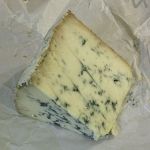By Cat, May 8, 2016 (Photo, right, from Wikimedia Commons)
When I was a kid, I didn’t like cheese, probably because what they served in the 1950s grade-school lunchroom was Velveta. But as an adult, I’ve learned to love cheeses of all stripes and flavors. My favorites are gorgonzola and brie, though Stilton (pictured, right) and gruyere are also high on the list.
Dairy has gotten a bad rap in the last 30 years, primarily because so many people have allergy or food sensitivity reactions to ultra-pasteurized milk. People don’t realize that raw and/or cultured milk does not produce the same reactions (see my posts: Why Pasteurize Milk? and Raw Milk: A Real, Natural & Perfect Food for more).
- Raw milk’s proteins are whole and natural – not denatured as they are after pasteurization.
- Culturing milk – as for yogurt, kefir or cheese – partially breaks down the proteins to a natural (non-denatured) condition; plus it increases the levels of vitamin K2, especially in cheeses like Gouda, Brie and Edam.
See also: 1. Foods (About) Menu, under Dairy; 2. Milk & Culturing of Milk (About)
Cheese: nutrients and benefits
Cheeses are naturally rich in (1):
- vitamins A, D, B2 and B12, and K2;
- minerals, including calcium, zinc and phosphorous;
- amino acids and protein; and
- high-quality saturated and omega-3 fats.
Other benefits (1):
- High-fat cheese has been shown to raise your HDL cholesterol (the so-called ‘good’ cholesterol), thought to be protective against metabolic diseases (like insulin resistance and cancer), and heart disease;
- Helps prevent NAFLD or non-alcoholic fatty liver and improves triglyceride and cholesterol levels – parameters used to gauge your cardiovascular disease risk;
- Roquefort cheese in particular has been linked to cardiovascular health and improved longevity, courtesy of its anti-inflammatory properties (2,3);
- Polyamines (protein derivatives having two or more amino acids) in aged cheeses are critical for cellular growth and survival. Those in full-fat aged cheese can be useful for weight management, in part by ramping up your metabolism. Polyamines are also found in the gut microbiota, where they likely play an important role for your immune system.
- Spermidine (and it’s derivative spermine) and putrescine are polyamines that are especially anti-inflammatory and protect DNA against free-radical damage, aiding in longevity.
- Polyamines in cheese and other foods have the ability to restore your internal body clock (1,4)
According to Mercola (1), but the bold emphasis in mine:
Make sure you’re eating real cheese. Natural cheese is a simple fermented dairy product made with just a few basic ingredients — milk, starter culture, salt and an enzyme called rennet. Salt is a crucial ingredient for flavor, ripening and preservation.
You can tell a natural cheese by its label, which will state the name of the cheese variety, such as “cheddar cheese,” “blue cheese” or “Brie.” Real cheese also requires refrigeration.
Processed cheeses are typically pasteurized and otherwise adulterated with a variety of additives that detract from their nutritional value. [One] tipoff on the label is the word “pasteurized.”
Other sources of polyamines
Cheese is not the only food high in polyamines; note also that fermentation increases polyamine levels. As a general rule (1):
- Fruits and cheese contain the highest levels of putrescine;
- Vegetables have the highest levels of spermidine; and
- Meat has the most spermine.
- Shellfish, including squid, oysters, crabs and scallops are high in polyamines;
- Mushrooms are high in polyamines;
- The Mediterranean diet is especially high in polyamines.
NOTE: processed foods made from the above whole foods are NOT high in polyamines. Also fish/shellfish must be wild-caught, not farm-raised.

